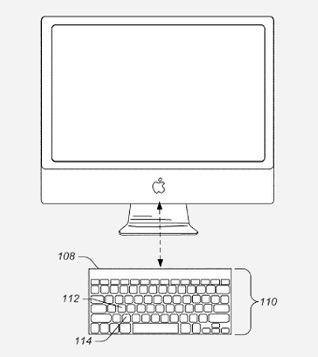An Apple patent (number 20110012717) for a method and apparatus for localization of haptic feedback has appeared at the US Patent & Trademark Office. The patent seems to indicate that the company is working on “virtual keyboards” for the Mac.
In one embodiment, a haptic feedback system includes a plurality of actuators to provide tactile feedback associated with an input surface. Each actuator is adapted to be activated independently of the other actuators. The system further includes a controller to activate a first actuator of the plurality of actuators to induce a first vibration at a selected input location of the input surface and to activate one or more additional actuators to induce at least a second vibration to localize the first vibration at the selected input location. The inventors are Aleksandar Pance, Paul Alioshin, Brett Bilbrey and David Thomas Amm.
Here’s Apple’s background and summary of the invention: “The present disclosure relates generally to methods and apparatus for providing haptic feedback, and more particularly relates to methods and apparatus for localizing of haptic feedback by limiting the effects of vibratory crosstalk between feedback positions.
“The term ‘haptic’ refers to touch or tactile sensation, and the term ‘haptic feedback system’ refers to a system configured to provide a selective tactile feedback sensation (such as a vibration or other physical sensation, etc.) at a contact location of a surface in response to contact of a user at that location. Such haptic feedback systems include an input surface and one or more actuators (such as piezoelectric transducers, electromechanical devices, and/or other vibration inducing devices) that are mechanically connected to the back of the input surface.
“Drive electronics coupled to the one or more actuators cause the actuators to induce a selected vibratory response into the surface to which they are attached, thereby providing a tactile sensation to a user. Many conventional devices, such as touch screen interfaces, have multiple feedback locations provided on a single surface, where typically each contact location will correspond to a user input location.
“With many such touch screen devices, a single actuator vibrates the entire surface relative to input at any one of several locations on the surface. Such devices offer essentially no localization of the haptic feedback. However, devices have been proposed where multiple actuators are distributed along the surface, each at a separate contact location, to provide some localization to the user feedback. However, because there are multiple actuator inputs into a single surface, the vibration can propagate to other locations, thus limiting the ultimate localization effect.
“The problem of propagating tactile sensations from the selected input location to other locations across the input surface (sometimes referred to as ‘vibratory crosstalk’ or ‘tactile crosstalk’) can be especially pronounced in multi-touch systems, such as a virtual keyboard or keypad, a multi-touch track pad, or a touch screen interface, having multiple contact locations. In such systems, the number of actuators can be increased to improve the granularity of the tactile sensation; however, such systems typically still suffer from undesired vibratory crosstalk.
“Haptic feedback methods and apparatus are disclosed that use a plurality of individually actuable actuators coupled to an input surface to induce vibrations into the surface, both to provide feedback vibratory response to a user, and also to assist in localizing that feedback vibratory response to the user input location. In response to a user selection at an input location, the system will generate a first feedback signal configured to provide a desired vibratory response to a user.
“The system will also induce vibrations at one or more other locations to suppress vibratory crosstalk resulting from at least the initial feedback signal. This suppression may range from changing the perceivable vibration response an another location to mask or otherwise obscuring the propagating vibratory crosstalk, to general cancellation (to at least some degree) of such vibratory crosstalk, such as through destructive interference.
“In some examples, the system includes a controller configured to activate a first actuator of the plurality of actuators to induce the described tactile feedback vibration at a selected contact location of the input surface, and further configured to activate one or more additional actuators to induce a suppression waveform vibration to assist in localizing the first vibration at the selected input location.”
— Dennis Sellers
dsellers@applecentral.com




